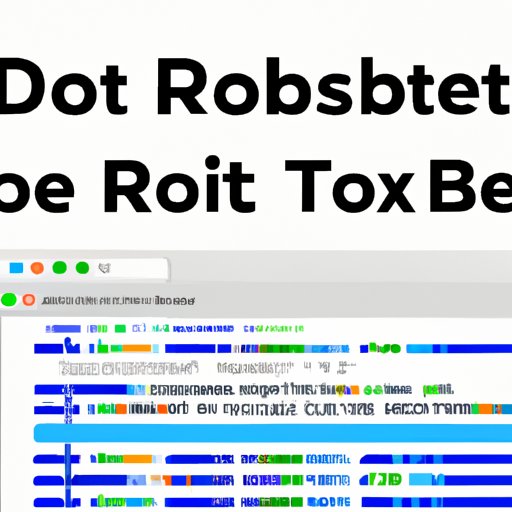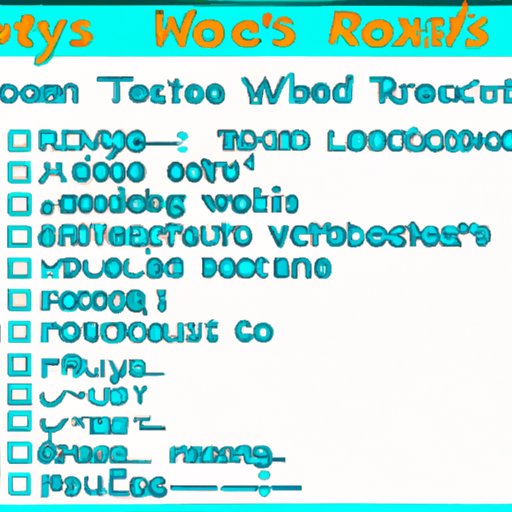Introduction
Robots.txt is a text file that helps webmasters and site owners control how search engine crawlers access their sites. It is used to tell search engines which pages or directories on your website should not be crawled and indexed by their bots. It also provides instructions for indexing your pages properly, making sure that search engine results are as accurate and relevant as possible.
Step-by-Step Guide to Creating a Robots.txt File
Creating a robots.txt file can seem like a daunting task, but it doesn’t have to be. With this step-by-step guide, you’ll be able to create a robots.txt file in no time. Here’s what you need to do:
Understanding the Syntax
The syntax of a robots.txt file is simple and straightforward. It consists of two parts: the user-agent line and the disallow line. The user-agent line tells the search engine which web crawler or “user agent” to use when accessing your site. The disallow line tells the search engine which pages or directories on your website should not be crawled and indexed.
Setting Up Your Domain
Before you can create a robots.txt file, you need to set up your domain. This involves registering your domain name and setting up hosting for your website. Once you’ve done this, you’ll be ready to start creating your robots.txt file.
Selecting Your User Agent
Once you’ve set up your domain, you need to select a user agent. This is the web crawler or “robot” that will be used to access your site. The most common user agents are from Google, Bing, and Yahoo, but there are many others as well. You can find a full list of user agents here: https://www.robotstxt.org/db.html
Defining Access Rules
Once you’ve selected your user agent, you need to define access rules. These are the instructions that tell the search engine which pages or directories on your website should not be crawled and indexed. For example, if you don’t want your login page to be indexed, you would add a rule like this: Disallow: /login. You can also use wildcards (*) to block entire directories or types of files. For example, if you don’t want any images on your site to be indexed, you could use a rule like this: Disallow: /*.jpg.
A Beginner’s Guide to Creating a Robots.txt File
If you’re new to creating a robots.txt file, then this beginner’s guide is for you. Here, we’ll take a look at what a robots.txt file is and how to create one. We’ll also cover some common mistakes to avoid.
What is a Robots.txt File and How to Create One
A robots.txt file is a text file that tells search engine crawlers which pages or directories on your website should not be crawled and indexed. To create a robots.txt file, you need to understand the syntax and set up your domain. Then, you need to select a user agent and define access rules. Finally, you can test and review your file to make sure it’s working correctly.
Common Mistakes to Avoid
When creating a robots.txt file, there are a few common mistakes to avoid. First, make sure that you specify the correct user agent. If you don’t, the search engine won’t be able to crawl your site correctly. Second, make sure that you use the correct syntax. If you don’t, the search engine may not understand your instructions. And finally, make sure that you review and update your file regularly. This will ensure that your instructions are always up-to-date.

How to Create and Manage Your Robots.txt File
Now that you understand the basics of creating a robots.txt file, let’s take a look at how to create and manage your robots.txt file. Here, we’ll cover setting up your file, verifying your settings, and troubleshooting errors.
Setting Up Your Robots.txt File
To set up your robots.txt file, you need to understand the syntax and set up your domain. Then, you need to select a user agent and define access rules. Once you’ve done this, you can save your file in the root directory of your website.
Verifying Your Settings
Once you’ve set up your robots.txt file, you need to verify your settings. This is important because it ensures that the search engine is crawling your site correctly. To do this, you can use a tool like Google’s Search Console or Bing’s Webmaster Tools.
Troubleshooting Errors
If you encounter any errors when setting up your robots.txt file, you can use the “Fetch as Google” tool in Google’s Search Console to troubleshoot them. This tool allows you to see exactly what the search engine sees when it crawls your site, so you can easily identify and fix any errors.

Setting Up Your Robots.txt File: Everything You Need to Know
In this section, we’ll take a closer look at setting up your robots.txt file. We’ll cover using wildcards, testing your file, and reviewing and updating your file.
Using Wildcards
Wildcards are a great way to block entire directories or types of files from being indexed. For example, if you don’t want any images on your site to be indexed, you could use a rule like this: Disallow: /*.jpg. Wildcards are a powerful tool, so make sure you use them wisely.
Testing Your File
Once you’ve set up your robots.txt file, it’s a good idea to test it to make sure it’s working properly. You can do this with a tool like Google’s Search Console or Bing’s Webmaster Tools. This will help you identify any errors or problems with your file before they become an issue.
Reviewing and Updating Your File
Finally, it’s important to review and update your robots.txt file regularly. This will ensure that your instructions are always up-to-date and that the search engine is crawling your site correctly. You should also check for any changes in the search engine algorithms to make sure your instructions are still valid.
Conclusion
Creating a robots.txt file is an important part of optimizing your website for search engines. It helps you control how search engine crawlers access your site, ensuring that your pages are indexed correctly and that your search engine results are as accurate and relevant as possible. To get started, follow the steps outlined in this guide and make sure to review and update your file regularly. With a little bit of effort, you can optimize your robots.txt file and improve your search engine rankings.

Benefits of Having a Robots.txt File
Having a robots.txt file provides several benefits for webmasters and site owners. It helps you control which pages are indexed by search engines, ensuring that only the most relevant and up-to-date content appears in search results. It also allows you to block certain files and directories, protecting sensitive information from being accessed by search engine crawlers. Finally, it can help optimize your website for search engine rankings, improving your visibility online.
Tips for Optimizing Your Robots.txt File
Optimizing your robots.txt file is an important part of optimizing your website for search engine rankings. Here are a few tips to help you get started:
- Make sure you specify the correct user agent.
- Use the correct syntax to ensure that the search engine understands your instructions.
- Take advantage of wildcards to block entire directories or types of files.
- Test your file regularly to make sure it’s working correctly.
- Review and update your file regularly to keep your instructions up-to-date.
(Note: Is this article not meeting your expectations? Do you have knowledge or insights to share? Unlock new opportunities and expand your reach by joining our authors team. Click Registration to join us and share your expertise with our readers.)
